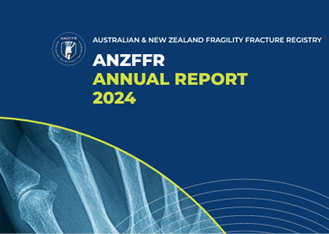First landmark report published by the Australia and New Zealand Fragility Fracture Registry

New Zealand has been a pioneer in terms of public support and national standardisation for Fracture Liaison Services (FLS). After the publication of the Australia and New Zealand Fragility Fracture Registry's (ANZFFR) first landmark report in March 2024 and in the context of development of the upcoming BoneCare 2030 strategy, IOF sat down with key experts in the New Zealand osteoporosis and fragility fracture landscape to learn more about national efforts to improve patient care, FLS management, and prevention of osteoporosis and fragility fractures in New Zealand.
The Australia and New Zealand Fragility Fracture Registry (ANZFFR) published its first landmark report in March 2024. The ANZFFR tracks the management and treatment of fragility fractures, allowing real-time audit of service quality in New Zealand. The inaugural report provides comprehensive analysis of the data generated through the Registry regarding the management and treatment of fragility fractures in New Zealand, including treatment efficiencies, patient recovery trajectories and preventative strategies.
An updated BoneCare 2030 national strategy is under development
New Zealand Fracture Liaison Services (FLS) are supported by several pillars including Osteoporosis New Zealand’s Clinical Standards for FLS, public funding from the Accident Compensation Corporation’s (ACC) Live Stronger for Longer Older Adult Fall and Fracture Prevention Programme, the ANZFFR, and the national BoneCare 2020 strategy. These multiple pillars have had a direct impact on the Capture the Fracture® (CTF) Map of Best Practice. The number of New Zealand FLS has grown by 143% since 2021, with several re-submissions.
Since the publication of BoneCare 2020 in December 2012, significant progress has been made in New Zealand in the care and prevention of fragility fractures. Paul Mitchell, a current member and past chair of the Board of Trustees of Osteoporosis New Zealand (ONZ) and Adjunct Associate Professor at the University of Notre Dame Australia, noted that the successor, BoneCare 2030, is currently in development. “This comprehensive national strategy aims to extend the benefits of optimal bone health to all New Zealanders through 2030 and beyond,” Mitchell said.
FLS services cover 87% of the New Zealand population - universal access planned by mid-2025.
A cornerstone of the national strategy to date has been the implementation and expansion of FLS, which play a pivotal role in secondary fracture prevention for New Zealanders aged 50 and over who have sustained fragility fractures. FLS in New Zealand benchmark their performance both nationally and internationally. Nationally, they aim to adhere to the second edition of the Clinical Standards for FLS in New Zealand, supported by participation in the NZ-arm of the ANZFFR. Internationally, the services seek to align with the IOF CTF®Best Practice Framework, with 17 FLS in New Zealand currently recognised on the IOF CTF® Map of Best Practice. These services cover 87% of the New Zealand population, with plans for universal access to IOF-accredited FLS by mid-2025.
Innovative "Refracture Tracker" feature helps alert FLS teams
The impact of the national FLS quality improvement programme led by ONZ and the ACC is already apparent. In the first year of ANZFFR operations (July 2022 to June 2023), the FLS Teams identified 55% of the estimated annual caseload of 22,300 fragility fracture patients aged 50 or over. This figure rose to more than 70% in the second year (July 2023 to June 2024). A key focus for ONZ is that every fragility fracture patient in New Zealand receives world-class care from an FLS. Given the exceptional performance of the FLS Teams in the first two years of registry operations, this goal should soon be within reach.
A key innovation in this effort is the "Refracture Tracker" feature on the ANZFFR, which alerts FLS Teams to patients presenting with a secondary fracture. This tool allows for timely modifications to treatment plans, further preventing subsequent fractures. Moreover, it provides real-time data on the effectiveness of FLS, offering invaluable evidence to New Zealand’s government agencies that fund the national programme.
BoneCare 2030 to propose a broader life course approach
Christine Gill, Clinical Programme Director at ONZ, emphasises the importance of a coordinated, multisector, and multidisciplinary approach: "The progress we've made in New Zealand demonstrates that when all stakeholders - healthcare providers, government agencies, and community organisations - come together with a shared vision, dramatic improvements can be achieved in a relatively short period. The Live Stronger for Longer Programme exemplifies this approach, and we hope it encourages other national osteoporosis societies to adopt similar comprehensive strategies for secondary fracture prevention."
While secondary fracture prevention remains a critical focus, BoneCare 2030 proposes a broader life course approach to bone health. This strategy includes clinical initiatives for both primary and secondary fracture prevention and the development of public health campaigns targeting people of all ages. Dr. Philippe Halbout, IOF CEO, remarked, “New Zealand's holistic approach to bone health, from clinical excellence to public health initiatives, sets a new standard for global fracture prevention. It's an inspiring model for other countries worldwide."